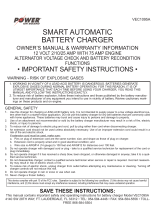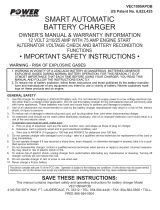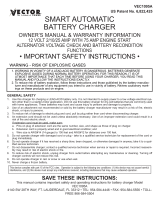
4
ENGLISH
X When disposing of batteries, follow the instructions
given in the section "Protecting the environment".
X Add distilled water in each cell until the battery acid
reaches the level specified by the battery manufacturer.
This helps to purge excess gas from the cells. Do not
overfill. For a battery without cell caps (maintenance
free), carefully follow the manufacturer's charging
instructions.
X Study all the battery manufacturer's specific
precautions, such as removing or not removing cell
caps while charging, and the recommended charging
rates.
X Make sure that the initial charging rate does not exceed
the battery manufacturer's requirement.
Warning! Risk of explosive gas mixtures. Working in the
vicinity of a lead-acid battery is dangerous. Batteries
generate explosive gases during normal battery operation.
For this reason, it is of utmost importance that each time,
before using your battery charger, you read this manual and
follow the instructions exactly.
X Use of an attachment not recommended or sold by
Black & Decker may result in a risk of fire, electric shock,
or injury to persons.
X An extension cord should not be used unless absolutely
necessary. Use of an improper extension cord could
result in a risk of fire and electric shock, and will void the
warranty.
LCD - Liquid Crystal Display
If any liquid crystal comes in contact with your skin:
X Wash area thoroughly with plenty of water. Remove
contaminated clothing. If liquid crystal gets into your
eye. Flush the affected eye with clean water and then
seek medical attention. If liquid crystal is swallowed:
Flush your mouth thoroughly with water. Drink large
quantities of water and induce vomiting. Seek medical
attention.
Personal safety
Wear complete eye protection and suitable clothing to give
protection from contact with battery fluid.
Avoid touching the eyes while working with a battery. Acid,
acid particles or corrosion may get into the eyes.
Remove personal metal items such as rings, bracelets,
necklaces and watches when working with a lead-acid
battery. A lead-acid battery can produce a short circuit
current high enough to cause a severe burn.
Be extra cautious to reduce the risk of dropping a metal
object onto the battery. This might cause sparks or short-
circuit the battery or other electrical part, which can cause an
explosion.
Preparation before charging
The appliance must only be connected to a 12 V lead-acid
battery. Before charging, confirm that the voltage of the
battery is 12 V by referring to the label on the battery or from
the information available relating to its application e.g. car
user manual.
Do not use the appliance for charging dry-cell batteries that
are commonly used with home appliances. These batteries
may burst and cause injury to persons and damage to
property.
Warning! Explosive gas may be vented from lead acid
batteries when charging. Make sure that the area is well
ventilated and remove any sources of ignition when
conducting charging procedures.
X Position the battery charger as far away from the battery
as the leads will allow. The battery charger contains
switches that may create a spark.
X Do not place the battery charger above or stand the
battery charger on top of the battery.
X Explosive gases may collect near the ground. Locate
the battery charger as high as possible above ground
level.
X Do not use power tools in the charging area.
X Do not smoke or have naked flames in the charging
area.
X Follow the instructions for connecting and disconnecting
the battery charger leads or battery terminals.
Warning! A marine (boat) battery must be removed and
charged on shore. To charge it on board requires equipment
specially designed for marine use. This appliance is NOT
designed for such use.
Vehicles may have electrical and electronic systems (e.g.
engine management systems, mobile phones) that may be
damaged if subjected to high starting voltages and voltage
peaks. Before connecting the appliance to the vehicle, read
the vehicle's owner's manual to confirm that external
charging is allowed.
X Follow these instructions and those published by the
battery manufacturer and vehicle manufacturer.
X Only connect and disconnect the dc output clamps after
removing the supply cord from the electric outlet. Never
allow clamps to touch each other.
X Check the polarity of the vehicle battery terminals
before connecting the appliance. Always disconnect the
negative (black) cable first: followed by the positive (red)
cable.
When charging a battery installed in the circuit follow the
manufacturers instructions for accessing the battery and the
following:
X Do not charge the battery while the engine is operating.









